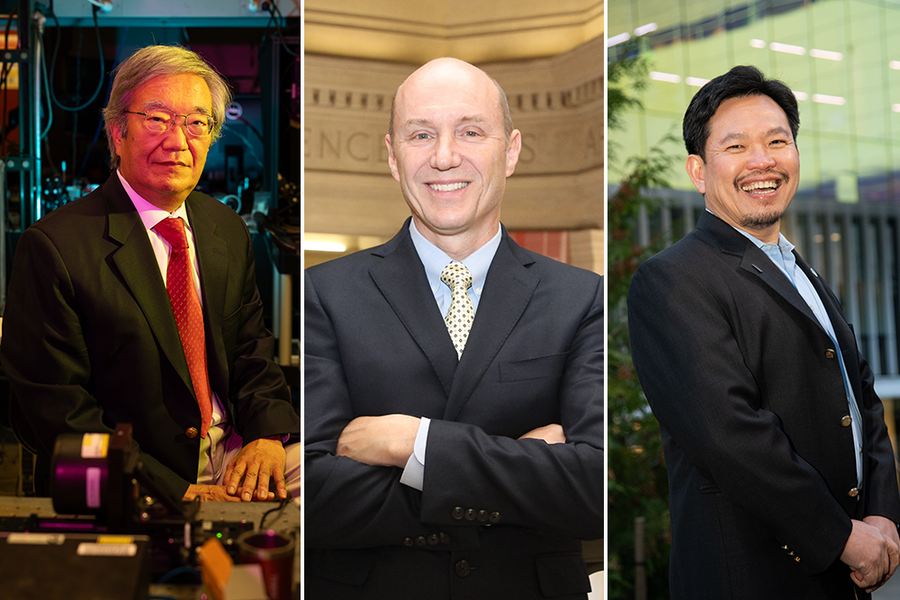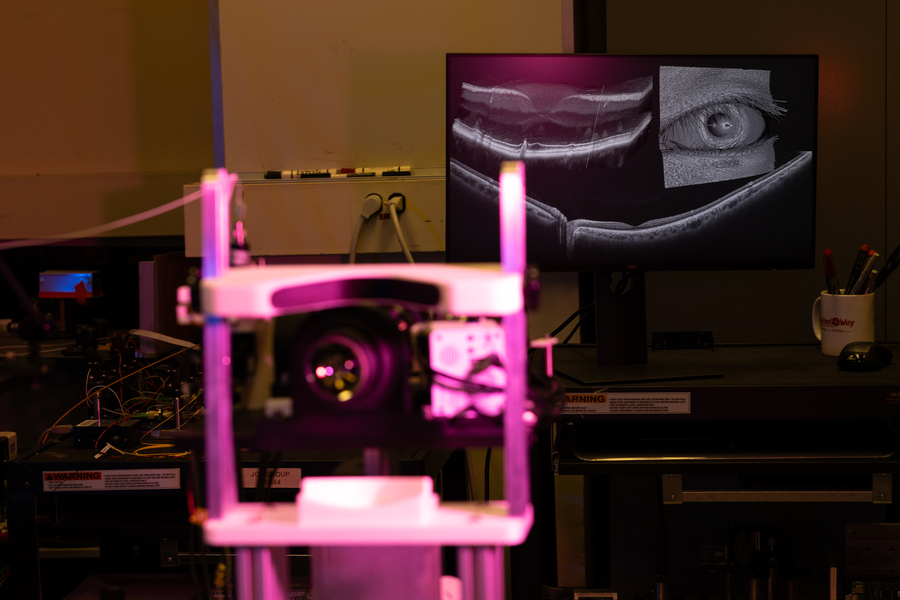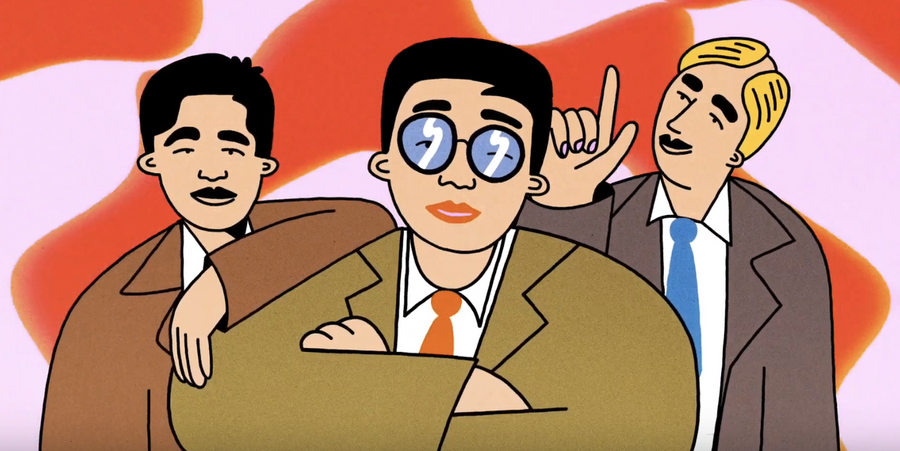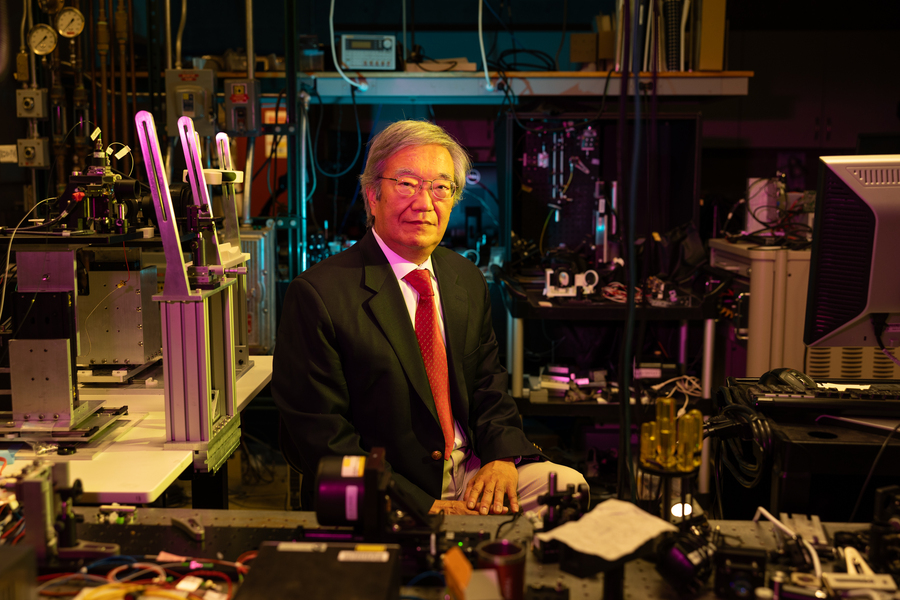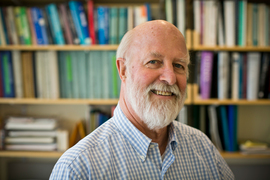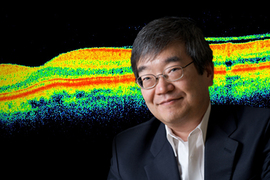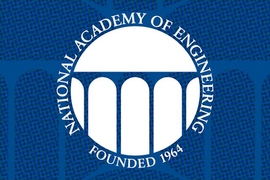The Lasker Foundation has named James Fujimoto ’79, SM ’81, PhD ’84, the Elihu Thomson Professor in Electrical Engineering and principal investigator in the Research Laboratory of Electronics (RLE), a recipient of the 2023 Lasker-DeBakey Clinical Medical Research Award for his groundbreaking work on optical coherence tomography. Fujimoto shares the award with Eric Swanson SM ’84, a research affiliate at MIT’s Research Laboratory of Electronics and mentor for the MIT Deshpande Center for Technological Innovation, and David Huang ’85, SM ’89, PhD ’93, professor of ophthalmology at Oregon Health and Science University.
Considered one of the most prestigious prizes for biomedical research, the Lasker Awards celebrate individuals who have “made major advances in the understanding, diagnosis, treatment, cure, and prevention of human disease.” A large percentage of Lasker Award recipients have gone on to win a Nobel Prize.
According to the Lasker Foundation citation, Fujimoto, Huang, and Swanson are being honored “for the invention of optical coherence tomography (OCT), a technology that revolutionized ophthalmology — allowing rapid detection of diseases of the retina that impair vision.” An animated video describing the work is available here.
“I am honored to be included among the recipients of this award,” says Fujimoto. “OCT represents the decades-long effort of a multidisciplinary partnership involving scientists, engineers, the clinical community, and industry. We are grateful for the opportunity to help to improve patient care and sincerely thank the Lasker Foundation.”
Prior to the invention of OCT, the standard methods of diagnosing ophthalmic disease were limited. In the early 1990s, Fujimoto, an electrical engineer and expert in advanced laser technologies, collaborated with satellite communications engineer Swanson — then at MIT Lincoln Laboratory — and MD-PhD student Huang to devise a better way to diagnose diseases. Using an optical technique known as interferometry, they developed a technology that could image the three dimensional microscopic structure of the living retina for the first time.
Their work, published in 1991 in the journal Science, revolutionized the field of ophthalmology and enabled a more precise way to detect disease and monitor treatment. Additional co-authors on this paper are Charles P. Lin, Joel S. Schuman, William G. Stinson, Warren Chang, Michael R. Hee, Thomas Flotte, Kenton Gregory, and Carmen A. Puliafito.
Revolutionizing ophthalmology with echoes of light
To understand how optical coherence tomography works, it’s useful to consider other imaging methods which use echoes. “OCT is an optical analogue of ultrasound or radar,” explains Fujimoto. “Instead of sound, it measures echo delays of reflected or scattered light in order to image the subsurface microstructure in tissues or materials in situ.”
The short wavelength of light allows for microscopic resolution of the images generated by OCT, but using light — as opposed to sound, which travels slower and has longer wavelengths — introduces thorny technological problems.
“The speed of light is extremely fast,” notes Fujimoto. “Light from the moon travels to earth in 1.3 seconds. So, in order to measure echo time delay over the very small dimensions in biological tissues, you need extremely high-resolution measurement technology.”
Here, Fujimoto, Swanson, and Huang found that their differing backgrounds enhanced their problem-solving capabilities.
“OCT uses many of the advances that were developed in high-speed optical communications,” explains Fujimoto. One of the team’s realizations was that infrared light provided good penetration of human tissues and interferometry could achieve the required high resolution and sensitivity. This made it possible to measure the “echo time” of reflected or scattered infrared light waves, thus creating a microscopic-resolution, three-dimensional image of subsurface structures inside tissues.
Performing Optical Biopsy
Importantly, the technology is not a substitute for ultrasound, CT or MRI, but rather a different tool with unique and complementary strengths. MRI, CT and ultrasound can penetrate deep into the body to create a full-body image, but have limited resolution. OCT can perform “optical biopsy,” imaging subsurface structure with microscopic resolution, without the need to excise and process specimens. OCT has limited imaging depth in tissues other than the eye, but can be combined with other optical instruments to image inside the body.
OCT could not have been developed without interdisciplinary collaboration with clinician scientists. Carmen Puliafito and Joel Schuman, then at the New England Eye Center and Tufts University School of Medicine, respectively, led the first clinical studies developing OCT in diabetic retinopathy, age related macular degeneration and glaucoma. These studies helped define the future clinical applications of OCT and commercialization in ophthalmology.
Retinal imaging became the largest application of OCT; in ophthalmologists’ offices worldwide, it is now considered the standard of care for diagnosing and monitoring eye disease. OCT has also helped improve understanding of disease mechanisms and accelerated development of new pharmaceutical treatments.
Many ophthalmologists say that OCT allows the non-specialist to detect disease with the sensitivity approaching that of a specialist. Diseases such as diabetic retinopathy, age-related macular degeneration, and glaucoma which may not produce noticeable symptoms at an early stage, can be detected and treated before there is irreversible vision loss.
Now, applications of OCT are being developed for even broader public usage outside of ophthalmology clinics. “In the future it will be possible to screen for diseases by having an automated OCT exam in local drug stores. The eye is a window on health – in addition to vision impairing eye diseases, OCT can enable detection of systemic disease such as diabetes and neurological conditions. The impact on public health could be immense,” explains Fujimoto.
OCT also has applications far beyond ophthalmology. The team quickly realized that fiber optics could be used to extend OCT’s reach into deeper areas of the body, imaging through catheters, endoscopes, and laparoscopes.
Intravascular imaging is the second largest application of OCT and was developed in collaboration with Mark Brezinski, a cardiologist at the Massachusetts General Hospital and Harvard Medical School. Brezinski demonstrated that OCT could detect unstable atherosclerotic plaques which cause heart attacks and led many of the first studies demonstrating OCT for optical biopsy.
“There are tissues that are not typically biopsied, such as retina, coronary arteries, nerves, and brain where OCT can provide information on pathology in situ and in real-time,” says Fujimoto. “Another application is surgical guidance — you can see beneath the tissue surface to avoid sensitive nerves and blood vessels before making an incision.”
With many research groups and clinics developing technology and applications, OCT stands as a shining example of the potential of interdisciplinary, and international, scientific cooperation. “Interdisciplinary collaboration is very popular now, but it was relatively uncommon in the 1990s, when OCT was first developed,” explains Fujimoto.
The success of OCT and its growing list of applications, is, for Fujimoto, a powerful reminder of the importance of cross-disciplinary work. “In medicine, as well as in many other fields, there is increasing use of technologies, including advanced hardware and analysis technologies as well as AI. Modern medicine can draw upon these technologies to advance patient care and reduce mortality.”
